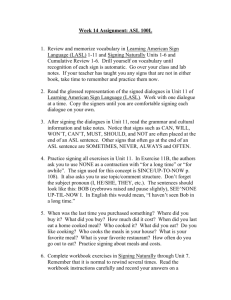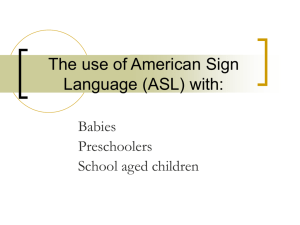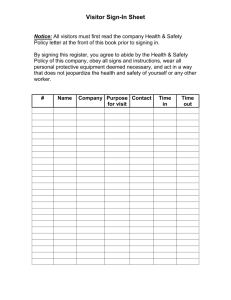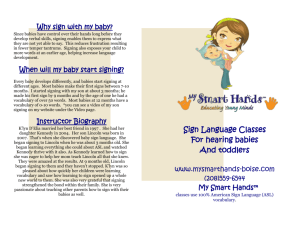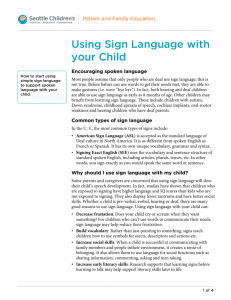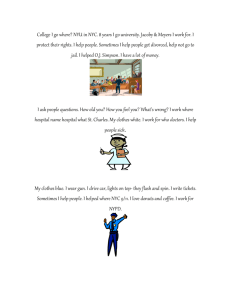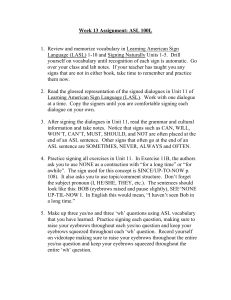The use of American Sign Language (ASL)
advertisement
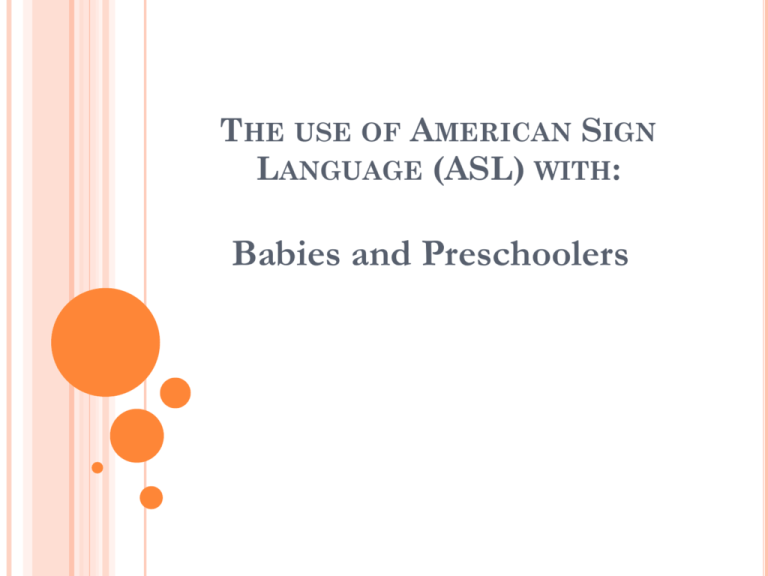
THE USE OF AMERICAN SIGN LANGUAGE (ASL) WITH: Babies and Preschoolers WHY USE ASL WITH HEARING BABIES? More picture PAT KUHL, NEUROSCIENTIST, STATED THAT WE USED TO THINK LANGUAGE BEGAN AT THE ONE YEAR STAGE WHEN KIDS STARTED PRODUCING THEIR FIRST WORDS AND THEY STARTED TO UNDERSTAND WORDS. NOW WHAT WE’RE LEARNING IS WELL BEFORE THE STAGE AT WHICH BABIES UNDERSTAND OR PRODUCE ANY WORDS AT ALL, THEIR HEARING SYSTEMS ARE BEGINNING TO BE SCULPTED BY LANGUAGE INPUT (HOCHBERG, MAY 1997) DR. JOSEPH GARCIA, AUTHOR OF SIGN WITH YOUR BABY HAS DISCOVERED THAT BABIES AS YOUNG AS 6 MONTHS ARE ABLE TO PRODUCE BASIC SIGNS SUCH AS ‘MILK’ OR ‘MORE’. 11-MONTH-OLD SIGNING BABY To view this video go to: http://www.mysmarthands.com/Si te/Baby_Signing_Interview_with_ a_signing_baby_in_action.html WHY USE ASL, WHY NOT MAKE UP YOUR OWN SIGNS? Eat THERE WAS A RECENT STUDY WHICH FOUND THAT SIX-MONTH-OLD HEARING INFANTS EXPOSED TO ASL FOR THE FIRST TIME PREFER IT TO PANTOMIME LENDING NEW EVIDENCE THAT HUMANS SHOW A BROAD PREFERENCE FOR LANGUAGES OVER “NONLANGUAGES”. (SCHWARZ, 2002) LONG TERM EFFECTS OF USING ASL WITH INFANTS Higher IQ’s when tested at ages 7 & 8 Increased spelling skills and reading comprehension Increased confidence CAN TEACHING A BABY SIGN LANGUAGE DELAY SPEECH? ABSOLUTELY NOT!!! DR. MARILYN DANIELS DESIGNED A STUDY WITH 16 HEARING CHILDREN WHO KNEW ASL; ALL BUT ONE OF THE CHILDREN HAD DEAF PARENTS. SHE FOUND THEY SCORED 17% HIGHER ON THE TESTS SHE ADMINISTERED THAN HEARING CHILDREN WHO DIDN’T KNOW ASL. SUBSEQUENT RESEARCH STUDIES WITH LARGER GROUPS HAVE FOUND THE SAME RESULTS. (DANIELS, 2001) WHY WOULD THIS BE? One reason may be that sign language increases overall brain activity, stimulating the formation of more synapses, or connections, among brain cells. Studies with PET scans have shown that children’s brains process signing both as a language, in the left side of the brain, and as image and movement, in the right side of the brain. This give the child two places to recall language. They are also being exposed to three different inputs: visual, observing the gesture; audible, hearing the word spoken along with the sign; and physical, feeling the sign used. And, as a growing body of research on early brain development shows, the more stimulation a child is exposed to at an early age, the more intelligent he or she is likely to be. WHY WOULD THE USE OF ASL INCREASE VOCABULARY AND LANGUAGE DEVELOPMENT? One reason for higher IQ’s could be that signing babies communicate about complex things earlier, helping them build the circuitry of their brains. A child who signs can elicit more communication and responses from adults and older children around him; providing him with a language-rich learning environment that allows him to develop a large vocabulary. RESEARCH HAS DEMONSTRATED REPEATEDLY THAT CHILDREN RETAIN WHAT THEY LEARN THROUGH FUN, PLAYFUL ACTIVITIES THAT ENCOURAGE THE USE OF MULTIPLE INTELLIGENCES 1. 2. 3. 4. 5. 6. 7. Physical learning (movement) Visual learning (seeing) Verbal learning (speaking or listening) Musical learning (music or rhymes) Mathematical learning (reasoning) Interpersonal learning (with other people) Intrapersonal learning (individual learning) PENELOPE LEACH STATES THAT “THE MORE LANGUAGE THEY (CHILDREN) HAVE, THE FASTER THINKING WILL PROGRESS. BUT THE MORE THINKING THEY ARE DOING, THE MORE LANGUAGE THEY WILL USE. SO LANGUAGE AND THOUGHT EVEN LANGUAGE AND INTELLIGENCE, ARE INTIMATELY ENTANGLED.” Milk I HOPE YOU CAN JOIN US AT ONE OF OUR FUN AND EDUCATIONAL CLASSES AT MY SMART HANDS AUSTIN! WWW.MYSMARTHANDS-AUSTIN.COM IMPORTANT WEBSITES: My Smart Hands, ‘educating young minds’ www.MySmartHands.com Mind Bites (videos on how to sign words and songs, go to the parenting & kids section) www.mindbites.com Babies and Sign Language www.babies-and-sign-language.com MY SMART HANDS AUSTIN CLASSES Learn Manual Alphabet (ASL) Learn 120+ in 8 weeks Fun and interactive Meet other parents in your area who are passionate about signing with their babies. Learn signs to songs and ways to incorporate signs into your everyday life Summer Classes Level One Class: June 22 – August 10 9:30am or 10:45am Heartsong Music on Anderson Lane, Austin Register today! RECOMMENDED READINGS: Daniels, Marilyn, (2001) Dancing With Words, Signing for Hearing Children's Literacy, Bergin & Garvey, Westport, CT. Garcia, Dr. Joseph (2005) Sign with your Baby, Northlight Communications, Inc. Seattle, WA RESOURCES Blackburn, D., Vonvillian, J., and Ashby, R. (January 1984). Manual Communication as an Alternative Mode of Language Instruction for Children with Severe Reading Disabilities. Language, Speech and Hearing Services in Schools,15, 22-31. Bonvillian, J., Cate, S., Weber, W., and Folven, R. (Fall 1988). Early Letter Recognition, Letter Naming and Reading Skills in a Signing and Speaking Child. Sign Language Studies, 271-289. Carney, J., Cioffi, G., and Raymond, W. (Spring 1985). Using Sign Language For Teaching Sight Words. Teaching Exceptional Children. 214-217. Christensen, K. (1984) Reading Sign Language - Use of a Visual-Gestural Mode to Supplement Reading Acquisition. Claremont Reading Conference Yearbook. 228-231. Daniels, M. (1996). Seeing Language: The Effect Over Time of Sign Language on Vocabulary Development in Early Childhood Education. Child Study Journal, 26, 193-208. Felzer, L. (1998). A Multisensory Reading Program That Really Works. Teaching and Change, 5, 169-183. Good. L.; Feekes, J.; Shawd, B. (1993/94). Let Your Fingers Do The Talking, Hands-on Language Learning Through Signing. Childhood Education, 81-83. Hafer, J. (1986). Signing For Reading Success. Washington D.C.: Clerc Books, Gallaudet University Press. Hochberg, Lee (1997). Child’s Play. www.pbs.org Koehler, L., and Loyd, L. (September 1986). Using Fingerspelling/Manual Signs to Facilitate Reading and Spelling. Biennial Conference of the International Society for Augmentative and Alternative Communication. (4'th Cardiff Wales). Schwarz, Joel (2002). Hearing infants show preference for sign language over pantomime. www.washington.edu Wilson, R., Teague, J., and Teague, M. (1985). The Use of Signing and Fingerspelling to Improve Spelling Performance with Hearing Children. Reading Psychology, 4, 267-273.
